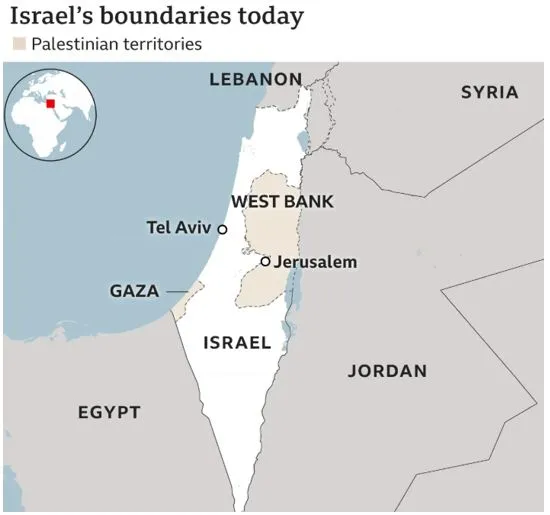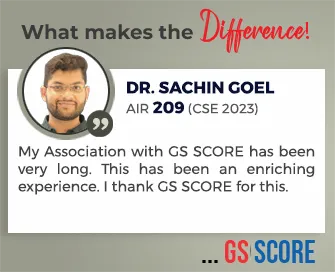

6th May 2025 (14 Topics)
Mains Issues
Context
Amid stalled ceasefire negotiations and continued hostilities, Israel’s Security Cabinet has approved a new military plan aiming to capture the entirety of Gaza and maintain a presence for an unspecified duration, increasing pressure on Hamas for hostage release and a ceasefire on Israeli terms.
Key Highlights of the Plan:
- Full Military Control: The Israeli army aims to take over all of Gaza, beyond the half it already controls, including border zones and key east-west corridors.
- Continued Displacement: The plan includes further displacement of Palestinians toward southern Gaza, worsening the humanitarian crisis.
- Strategic Pressure on Hamas: The move is designed to coerce Hamas into concessions, particularly on the hostage issue and ceasefire terms.
- Humanitarian Crisis Deepens:
- Mass Displacement: Over 90% of Gaza’s population (2.3 million) has been displaced — many repeatedly.
- Aid Blockade and Hunger: Since early March, Israel halted aid into Gaza, creating famine-like conditions and widespread looting.
- Casualties: According to local health officials:
- Over 52,000 Palestinians killed, many women and children.
- Strikes since March 18 alone have killed over 2,600.
- Infrastructure Destruction: The territory is described as an "uninhabitable moonscape", with vast devastation and collapsed services.
Background of the Conflict
- The conflict between Israel and the Palestinian people roots go back over a century and are primarily centered on issues such as land ownership, borders, and national identity.
- Before 1948, the region was known as Palestine and was under Ottoman rule until World War I.
- After the defeat of the Ottoman Empire, Britain took control of the area under a League of Nations mandate. The region had a majority Arab population and a minority Jewish community, along with other ethnic groups.
- Tensions began to rise after the 1917 Balfour Declaration, in which Britain supported the idea of establishing a “national home for the Jewish people” in Palestine. While Jews saw this as a restoration of their historical homeland, Palestinian Arabs, who had lived there for centuries, strongly opposed this move.
- Jewish Migration and UN Partition Plan: From the 1920s to the 1940s, Jewish immigration to Palestine increased significantly, especially as many Jews fled persecution in Europe. The Holocaust, in which six million Jews were murdered, further intensified the global Jewish demand for a safe homeland.
- By 1947, Jews made up about 30% of the population. Violence between Jews and Arabs had escalated. The UN proposed a partition plan to divide Palestine into separate Jewish and Arab states, with Jerusalem as an international city. Arab nations rejected this plan, claiming it unfairly favored the Jewish population.
Creation of Israel:
- On 14 May 1948, the Jewish leadership declared the establishment of the State of Israel, just before the British withdrawal.
- The following day, armies from five Arab countries attacked Israel, leading to the first Arab-Israeli war.
- Israel emerged victorious and expanded its territory beyond what the UN plan had allocated.
- Egypt took control of the Gaza Strip
- Jordan occupied the West Bank and East Jerusalem
- Israel held West Jerusalem
- About 750,000 Palestinians fled or were expelled during the war, an event known to Palestinians as the "Nakba," or "Catastrophe." Many became long-term refugees.
- The 1967 Six-Day War: In 1967, tensions again erupted into war, known as the Six-Day War. Israel launched a preemptive strike against Egypt and quickly defeated the armies of Egypt, Syria, and Jordan. Israel captured the Sinai Peninsula and Gaza Strip from Egypt, the West Bank and East Jerusalem from Jordan, and the Golan Heights from Syria.
- This war brought about a new phase of Israeli occupation. Over a million Palestinians came under Israeli control in the West Bank, East Jerusalem, and Gaza. Israel later returned the Sinai Peninsula to Egypt in a 1979 peace agreement but annexed East Jerusalem and the Golan Heights—actions not recognized by most of the international community.
- Key-locations:
- West Bank: The West Bank is home to about three million Palestinians and is considered part of the Occupied Palestinian Territories, along with East Jerusalem and Gaza. Israel retains overall control.
- Jerusalem: Israel controls the entire city and considers it its indivisible capital, while Palestinians claim East Jerusalem as the capital of a future Palestinian state. The city is home to key religious sites for Jews (Temple Mount), Muslims (Al Aqsa Mosque compound), and Christians.
- Gaza Strip: The Gaza Strip is surrounded by Israel, Egypt, and the Mediterranean Sea. Originally occupied by Egypt after the 1948 war, Gaza was captured by Israel in the 1967 war. After Hamas won elections in 2006 and took full control of Gaza in 2007, Israel and Egypt imposed a blockade. Since then, several major conflicts have erupted between Hamas and Israel.



Mains Issues
Context
Under India's Insolvency and Bankruptcy Code (IBC), when a company cannot repay its debts, a structured process called the Corporate Insolvency Resolution Process (CIRP) allows for either its revival through a resolution plan or liquidation. The recent Supreme Court judgment cancelling JSW Steel’s resolution plan for Bhushan Power & Steel Ltd (BPSL) has brought attention to serious procedural lapses and legal violations in high-value insolvency cases.
What is IBC?
- The Insolvency and Bankruptcy Code (IBC), 2016 is a legal framework to resolve financial stress in companies.
- It aims for time-bound resolution of bad loans through either:
- A resolution plan (reviving the company), or
- Liquidation (selling assets to repay creditors).
- Key Steps in Insolvency Resolution:
- Initiation: A creditor or the company itself applies for insolvency at the NCLT.
- CIRP (Corporate Insolvency Resolution Process) begins. An RP (Resolution Professional) is appointed.
- CoC (Committee of Creditors) evaluates and votes on resolution plans.
- If approved, the plan is sent to NCLT for final approval.
- If no plan is approved within the timeline, liquidation follows.
What Did the Supreme Court Say?
The Supreme Court rejected JSW Steel’s plan and ordered liquidation of BPSL for several serious reasons:
- Missed Legal Timelines: Under IBC, the resolution process must be completed within 270 days (can be extended to 330 days in special cases). JSW’s plan was approved by the CoC in Oct 2018, but submitted to NCLT only in Feb 2019. The court found no valid reason for this delay, making the entire process time-barred.
- Violation of Section 29A of IBC: Section 29A disqualifies defaulting promoters or those “acting in concert” with them from submitting resolution plans. The court found the RP failed to check JSW’s eligibility under this rule. It raised questions about connected entities or promoters, possibly being ineligible.
- Unfair Treatment of Operational Creditors: Section 30(2) of IBC requires fair and equitable treatment of all creditors. Operational creditors (suppliers, vendors) argued that their dues were not fairly addressed. The court agreed, noting a lack of transparency and diligence.
- Failure to Address Avoidance Transactions: RPs are supposed to check for fraudulent or undervalued transactions by the former management (called avoidance transactions). The RP did not take proper action, weakening the credibility of the entire process.
- Delayed Implementation by JSW Steel: After NCLT cleared the plan in 2019, JSW Steel delayed payments to creditors for over 2 years, until 2021–22. The court said this delay may have helped JSW gain from rising steel prices, raising concerns of commercial opportunism.
Why is this a big deal?
This ruling could change how insolvency resolutions work in India, especially for large deals:
- It shows courts will strictly enforce timelines, not tolerate delays.
- Resolution professionals (RPs) must now act more diligently — in checking eligibility, treating creditors fairly, and pursuing frauds.
- It puts commercial wisdom of creditors under scrutiny when due process is not followed.
- Raises concerns for investors and bidders about the finality and enforceability of approved resolution plans.
Wider Implications
- For the IBC Ecosystem: This judgment reasserts IBC’s core principles — speed, transparency, and fairness. But it may also make large investors more cautious, as even approved plans can be reversed.
- For Operational Creditors: A rare case where operational creditors won — often they are left behind in the resolution process. It could lead to stronger enforcement of their rights going forward.
- For Promoters and RPs: RPs can no longer be passive facilitators — they must now show rigorous compliance. Promoters or their allies can’t find backdoor entries into the resolution process.
Fact Box:About Non-Performing Assets (NPAs)
About National Company Law Tribunal (NCLT)
|
PYQ:Q: Consider the following statements: (2018) Non-performing assets (NPAs) decline in value when-
Which of the above statements are correct?
Solution: (c) |


Mains Issues
Context
In a landmark case, the central government has taken a strong position before the Supreme Court regarding the taxation of online games under the Goods and Services Tax (GST) framework. The Centre has argued that it makes no difference whether a game is based on skill or chance when it comes to tax classification. The core argument is that any form of betting on an outcome, regardless of whether the underlying game is skill-based or chance-based, should be treated as gambling for tax purposes.
Key-Arguments made by the Government
- Petitioners argue that such a tax regime violates Article 14 (equality before law) and Article 19(1)(g) (freedom to practise any profession). They say it unfairly places skill-based games in the same category as games of chance, imposing disproportionate financial and compliance burdens.
- Government’s Arguments:
- Stakes Define the Activity: The classification of a game as skill-based or chance-based is irrelevant when determining its tax liability.
- The activity of betting on the outcome of any game, regardless of its nature, falls under the broader umbrella of gambling.
- GST Law Operates Independently: Even in states like Nagaland, where skill-based games are allowed and legally protected, betting on the outcomes of those games should still be categorized as gambling and subjected to the 28% GST rate.
- Valuation Rules Are Valid: Rule 31A(3) of the CGST Rules, which is under challenge, is consistent with earlier court-approved frameworks.
- Centre Has Taxing Power: The 101st Constitutional Amendment gives the Centre taxation rights over betting and gambling. State regulatory powers do not override this.
- If the Supreme Court upholds this stance, it could result in many online gaming platforms facing the same tax burden as traditional gambling activities, which would make participation in games like fantasy sports significantly more expensive for users.
TaxationTraditionally, the online gaming industry had been paying GST at 18 per cent, treating its activity as a service. This interpretation was disputed by the GST authorities, who chose to characterise the activity as betting and gambling, thereby subject to 28 per cent GST. |
Gambling Laws in India
- Online gambling in India falls into a gray area because there are no specific laws at the national level regulating it.
- Gambling in India has long been regulated by colonial-era laws like the Gaming Act of 1845 and the Betting Act of 1853, which were enacted during British rule to govern gambling activities.
- Now, gambling is a state subject under the Indian Constitution, each state has the power to create laws governing gambling within its jurisdiction.
- For instance, some states like Nagaland have legalized certain forms of skill-based gaming, including fantasy sports, while others, like Tamil Nadu, have imposed a ban on online gaming activities.
- Telangana was one of the first states that banned online gambling with a legislation in 2017, which was then followed by Kerala, Tamil Nadu, Andhra Pradesh and very recently, Karnataka.
- The Prevention of Money Laundering Act 2022, Telecom Commercial Communications Customer Preference Regulations 2010, The Prize Competition Act 1955, Foreign Exchange Management Act 1999 and the Cable Television Network Rules 1994 put forth some regulations on the promotion of gambling.
Challenges
- Conflicting state laws: This inconsistency has led to a lack of clarity, creating challenges for businesses that operate across state lines.
- Regulatory vacuum: There is no central authority or set of laws to govern the sector as a whole.
India’s Online Gaming Sector
|


Mains Issues
Context
India is set to conduct a nationwide civil defence mock drill, aimed at testing emergency preparedness in the wake of rising border tensions and the terror attack in Pahalgam that killed 26 civilians on April 22.
What are Civil Defence districts in India?
- Civil Defence districts are designated regions where the Government of India actively implements civil defence programs.
- These districts serve as administrative and operational hubs for preparedness activities in case of emergencies like wars, air raids, missile strikes, or large-scale terror attacks.
- Their role is to organize resources, train civilians and volunteers, and coordinate responses involving multiple government and civilian agencies.
- They carry out functions such as:
- Training and mobilizing volunteers
- Conducting blackout and evacuation drills
- Managing coordination with Home Guards, NCC, NSS, NYKS, police, and local authorities
- Running public awareness campaigns and shelter planning
What is a Civil Defence mock drill?
- A civil defence mock drill is a planned simulation of emergency scenarios — such as an aerial attack or missile strike — to test public and administrative readiness.
- These drills are governed by the Civil Defence Rules, 1968, and simulate situations like:
Power blackouts- Air raid sirens
- Evacuation alerts
- Emergency communication breakdowns
- Shelter-in-place protocols
- The mock drills help reduce civilian panic, identify response gaps, train volunteers and responders and build awareness and resilience.
- The exercise is not a signal of imminent conflict but part of a longstanding framework under the Civil Defence Rules, 1968 — regulations dating back to the Cold War era but being recalibrated for contemporary threats.


Mains Issues
Context
As the global biodiversity crisis intensifies, conservation efforts around the world are facing criticism for sidelining Indigenous Peoples and Local Communities (IPLCs). In this backdrop, India’s Forest Rights Act (FRA), 2006, offers a unique legal framework that integrates biodiversity conservation with the rights and traditional knowledge of Adivasis and other forest-dependent communities.
How the Forest Rights Act (FRA) makes India different?
- India’s Scheduled Tribes and Other Traditional Forest Dwellers (Recognition of Forest Rights) Act, 2006, commonly known as the Forest Rights Act (FRA), offers a progressive legal model that integrates indigenous rights with biodiversity conservation.
- It embodies all these principles and provides the legal framework for securing forest tenure and other pre-existing rights of Adivasi and local communities.
- · Key Contributions of FRA:
- Recognises the historical injustice faced by Adivasis and forest dwellers who were denied legal rights to their ancestral lands.
- Empowers gram sabhas (village assemblies) to manage and govern community forest resources.
- Recognises a range of rights — from individual land titles to community rights over forest produce, biodiversity, and traditional knowledge.
- Legally enables a bottom-up approach to forest governance, unlike the top-down, state-led protected area model.
- This makes India one of the few countries where conservation and indigenous rights are not in conflict by law, at least on paper.
Why IPLCs matter for biodiversity?
- Globally, there's a growing recognition that indigenous communities are crucial for conservation. Research has shown that biodiversity thrives better in territories managed by IPLCs than in many state-run protected areas.
- International institutions have also taken note:
- Convention on Biological Diversity (CBD): Through Article 8(j), it urges countries to respect and integrate traditional knowledge and practices in biodiversity conservation.
- UN Declaration on the Rights of Indigenous Peoples (2007): Affirms the rights of IPLCs to manage their own lands and resources.
- Kunming-Montreal Global Biodiversity Framework (2022): Envisions a more inclusive conservation approach and targets like "30 by 30", which aims to bring 30% of the world's lands and oceans under conservation by 2030 — with community participation.
- However, the implementation remains uneven, and fortress-style conservation still displaces communities in several countries.
India’s Constitutional and Legal Support for IPLCs:
- While India does not officially use the term "indigenous peoples", it has a strong constitutional framework to support Scheduled Tribes through:
- Fifth and Sixth Schedules
- PESA Act, 1996 (recognising self-rule in tribal areas)
- Constitution of India provides Articles 244 & 244A, enabling tribal governance in Scheduled Areas.
- With over 104 million Adivasis, India has the world’s largest indigenous population in a single country.
- Laws like the FRA and PESA allow for a unique and legally supported model of decentralised, democratic resource management.
Gaps between Policy and Practice (Challenges)
Despite progressive laws like FRA, India's biodiversity governance still faces major issues:
- Implementation Gaps: The Forest Rights Act has not been effectively implemented in many states. Many communities still await title recognition.
- Displacement under Protected Areas: India has over 1,134 protected areas, and at least 6 lakh people have been displaced due to such conservation models.
- Updated Biodiversity Action Plan (NBSAPs): While India’s new plan under CBD mentions bottom-up governance and community rights, it still relies heavily on State-led mechanisms and does not fully integrate the FRA framework.
- Weakening of Biodiversity Management Committees (BMCs): These local institutions are often under-resourced or not functional. Without their full operationalisation, inclusive biodiversity governance is difficult.


Prelims Articles
Context
After Independence, India promised to reorganise states on linguistic lines. But the Marathi-speaking population was denied a unified state, even as states like Andhra were formed based on language. This led to a mass movement demanding a “Samyukta Maharashtra” (United Maharashtra) with Mumbai as its capital.
What Was the Samyukta Maharashtra Movement?
- The Samyukta Maharashtra Movement (1946–1960) was a mass movement demanding a separate state for Marathi-speaking people including regions like Mumbai, Vidarbha, Marathwada, Belgaum, Karwar, and Nippani.
- The core demand was for a unified state called ‘Samyukta Maharashtra’ with Mumbai (Bombay) as its capital, and it sought to bring together Marathi-speaking regions including Mumbai, Marathwada, Vidarbha, Belgaum, Karwar, and Nippani.
- It was not just a political demand, but also a cultural assertion of Marathi language, identity, and historical legacy, tracing back to the Maratha Empire under Shivaji.
- Importance of Mumbai to the Movement: Mumbai (then Bombay) was:
- Economically powerful, being India’s financial and industrial hub
- Culturally significant to Marathi people, despite also having large Gujarati, Parsi, and other communities
- Home to Maharashtrian working-class communities, mill workers, artists, and intellectuals
- However, Gujarati-speaking elites and business communities, with support from the Bombay Citizens Committee, wanted Bombay to remain a separate bilingual or centrally administered area.
- This led to intense conflict, as Marathi-speaking masses saw Mumbai as inseparable from Maharashtra, not only for emotional reasons but for practical and cultural ones as well.
- Formation of Maharashtra (1960): The Samyukta Maharashtra Movement finally achieved its goal when, on May 1, 1960, the state of Maharashtra was formed with Mumbai as its capital. Simultaneously, Gujarat was also carved out, satisfying the demands of both linguistic groups.
Key-Figures Involved:
- Annabhau Sathe: Lokshahir Annabhau Sathe played a crucial cultural role in mobilising the masses, especially the rural and working-class Marathi-speaking people. He was a folk artist, writer, and activist from a Dalit background.
- He was the founder of the Lal Bavta Kalapathak (Red Flag Cultural Troupe), which performed across villages to spread awareness of the movement
- His iconic song "Majhi Maina Gavavar Rahili" became an anthem of the movement, emotionally uniting people.
- Annabhau Sathe’s cultural activism helped bridge class, caste, and gender boundaries, giving the movement a broad-based and inclusive character.
- Dr. B. R. Ambedkar: Dr. Ambedkar, though not always acknowledged in mainstream narratives of this movement, was a pioneering voice for Samyukta Maharashtra:
- As early as 1948, his party, the Scheduled Caste Federation (SCF), introduced a resolution in the Bombay Municipal Corporation demanding a unified Marathi state.
- He submitted proposals to the Dhar Commission, which was set up to examine the viability of linguistic states.
- In his writings such as "States and Minorities" and "Thoughts on Linguistic States", he argued that linguistic states could empower marginalized communities and enhance administrative efficiency.
- Resistance and Setbacks Despite popular support, the movement faced:
- Opposition from Gujarati elites, business interests, and central leaders
- Resistance from RSS leaders like M.S. Golwalkar
- Suppression by police, leading to the death of over 100 protesters
- Indifference from national leaders, until pressure from electoral defeats and public protests forced a change in approach
- In fact, it was only after continued unrest and the resignation of Union Finance Minister D. Deshmukh in protest that Nehru began to seriously reconsider.


Prelims Articles
Context
India has temporarily appointed Parameswaran Iyer, the current Executive Director at the World Bank, as its nominee to the International Monetary Fund (IMF) following the premature exit of K V Subramanian. This development comes just ahead of a crucial IMF board meeting, where key decisions about loans to Pakistan—including a USD 1.3 billion climate resilience loan and a review of a USD 7 billion bailout package—will be taken.
About International Monetary Fund (IMF)
- Establishedin: 1944 in the aftermath of the Great Depression of the 1930s.
- The International Monetary Fund (IMF) is a Bretton Woods institution, established in 1944, and formally came into existence in 1945.
- Headquarter: Washington, D.C., USA.
- Main Objectives
- Promote international monetary cooperation.
- Ensure exchange rate stability.
- Facilitate balanced growth of international trade.
- Provide financial assistance to member countries in balance of payments crisis.
- Assist in poverty reduction and macroeconomic stability, especially in developing nations.
- IMF Lending Programs (Important Schemes): Stand-By Arrangement (SBA); Extended Fund Facility (EFF); Rapid Financing Instrument (RFI); Resilience and Sustainability Trust (RST)
- The IMF is governed by and accountable to 191 countriesthat make up its near-global membership. India is a founding member of the IMF.
- Quota share: 2.75% (India is among the top 10 largest quota-holding countries).
- India has a permanent seat on IMF’s 24-member Executive Board.
- Each country (or a group of countries) at the IMF is represented by an Executive Director.
- India has a dedicated seat on the IMF Board, which is responsible for:
- Participating in voting on loan approvals.
- Influencing decisions on policy frameworks, economic assessments, and emergency assistance.


Prelims Articles
Context
The United States has raised concerns at the World Trade Organization (WTO) about India’s Production Linked Incentive (PLI) scheme for speciality steel, questioning its compatibility with WTO rules. The US argued that the scheme promotes increased steel production despite global overcapacity in the metal, potentially distorting the international market.
US Argument at the WTO
- The US highlighted global overcapacity in steel, especially due to countries like China.
- It questioned India’s rationale behind subsidising more production when the international steel market is already saturated.
- It expressed concern that such subsidies could distort trade flows and undercut global pricing.
- WTO's Agreement on Subsidies and Countervailing Measures (ASCM) restricts certain subsidies, especially if they are:
- Contingent on export performance, or
- Tied to use of domestic over imported goods
- India’s position: India, however, has defended its position strongly, stating that:
- The scheme aims to reduce import dependence for high-grade steel.
- National self-sufficiency in key sectors like speciality steel is critical for strategic autonomy.
- It is WTO-compliant as it does not link incentives to export performance.
- The PLI scheme is a calibrated and modest support mechanism, especially when compared to China’s USD 50 billion subsidies in its steel sector.
- Even the US, which has raised objections, has used tariffs and domestic support to protect its steel industry for national security reasons.
What is Speciality Steel and Why Is It Crucial for India?
- Speciality steel refers to high-end, value-added grades of steel used in critical sectors like:
- Defence and aerospace
- Power and energy
- Automobiles and infrastructure
- Despite being the world's second-largest steel producer, India is a net importer of such speciality grades. This creates vulnerabilities in terms of:
- Strategic security
- Technological backwardness
- Trade deficits
PLI scheme for Specialty Steel
|


Prelims Articles
Context
A new study published in the journal Cell reports the successful genome sequencing of the saola (Pseudoryx nghetinhensis), a critically endangered species native to the Annamite Mountains of Vietnam and Laos. Often dubbed the "Asian unicorn" due to its extreme rarity and elusive nature, the saola remains one of the least understood large mammals on Earth.
Key Highlights (Genome Sequencing and Findings)
- Scientists generated complete genomes for 26 saola specimens, using DNA fragments from remains collected in hunter households.
- Genetic analysis revealed that the saola population split into two genetically distinct groups approximately 5,000–20,000 years ago.
- This coincides with climatic and ecological changes during and after the Last Glacial Maximum.
- Additionally, human transitions to agriculture (~4,000 years ago) in the region likely contributed to the species’ isolation through habitat destruction, hunting, and forest fragmentation.
- Both saola populations have lost genetic diversity but in different ways, meaning:
- Their remaining gene pools are complementary.
- A genetic rescue strategy could involve interbreeding individuals from both groups to restore overall diversity.
About Saola (Pseudoryx nghetinhensis)
 |


Prelims Articles
A drug originally developed to treat diabetes, and now prescribed for weight loss, may have yet another significant application: stopping, perhaps even reversing, liver disease.
About Ozempic
- Ozempic is the brand name for the drug semaglutide, a GLP-1 receptor agonist.
- It was originally developed to treat type 2 diabetes, but has since gained widespread use for weight loss.
- It belongs to the class of GLP-1 (Glucagon-like peptide-1) drugs, which mimic a natural hormone in the body.
- How Does Ozempic Work?
- It stimulates insulin secretion.
- It slows down gastric emptying, which prolongs feelings of fullness.
- It suppresses appetite, leading to lower food intake.
- It reduces “food noise” (constant preoccupation with food), which can be helpful in binge eating disorders.


Prelims Articles
Context
Kerala has witnessed the tragic deaths of three children due to rabies in the past month, despite them being vaccinated. This has sparked concern about vaccine efficacy, wound care awareness, and public health response.
What is Rabies?
- Rabies is a viral disease causing fatal inflammation of the brain and spinal cord.
- It is transmitted via bites or saliva from infected animals, primarily dogs.
- Prevention:
- Post-Exposure Prophylaxis (PEP): Immediate wound washing, followed by vaccination and sometimes rabies immunoglobulin.
- Pre-Exposure Prophylaxis (PrEP): Preventive vaccination for high-risk populations.
- Fatality: Once symptoms appear, rabies is almost always fatal.
- Rabies is 100% preventable but still causes around 20,000 deaths annually in India (as per WHO).


Editorials
Context
India declared the Indus Waters Treaty (IWT) of 1960 to be in ‘abeyance’, in response to Pakistan’s continued support for cross-border terrorism, especially after the Pahalgam terror attack. The move signals a temporary suspension of cooperation under the treaty, aimed at pressuring Pakistan without officially terminating the treaty.
LEGAL STANDING AND STRATEGIC CALCULATION
- Lack of Legal Basis for 'Abeyance': The term ‘abeyance’ has no legal recognition under either the IWT or the Vienna Convention on the Law of Treaties (VCLT, 1969). India is not a party to the VCLT, and even under customary international law, unilateral suspension of treaty obligations is not legally valid, making the move more symbolic than enforceable.
- Articles of IWT and VCLT Constraints: Articles XII(3) and (4) of IWT mandate mutual ratification for modification or termination, and VCLT Articles 60–62 allow suspension only in cases of material breach, impossibility, or fundamental change, none of which India has formally invoked, limiting India’s legal maneuverability.
- Tactical Pause in Treaty Implementation: The ‘abeyance’ allows India to withhold procedural cooperation, such as sharing hydrological data or notifying reservoir operations, thereby impairing Pakistan’s flood forecasting and water security, while avoiding overt treaty violation.
TWO-LEVEL GAME: DOMESTIC SENTIMENT VS DIPLOMATIC SIGNAL
- Domestic Political Calculations: The Cabinet Committee on Security likely adopted abeyance to satisfy public sentiment, showing decisive action after a terror attack, and to gain room for infrastructure advancement on run-of-the-river projects on western rivers like Ratle and Tulbul.
- Diplomatic Risks of Escalation: Using IWT as a counter-terror tool is a high-stakes gamble, as Pakistan sees it as an existential threat. Given Pakistan’s domestic instability and weakened military-civil dynamics, the move risks international escalation and misinterpretation.
- Structural Delays in Project Execution: Despite political will, India’s hydel infrastructure projects face regulatory, environmental, and procedural hurdles, such as clearances in ecologically sensitive zones, which limit immediate material benefits from suspending the treaty.
LONG-TERM STRATEGIC, ENVIRONMENTAL, AND GLOBAL REPERCUSSIONS
- Damage to India’s Global Image: India’s unilateral invocation of abeyance may undermine its image as a responsible global actor, potentially inviting international legal proceedings under the Permanent Court of Arbitration or International Court of Justice.
- Ecological Fallout of Fast-tracking Projects: Accelerated project execution in the Indus basin, a seismically and ecologically fragile region, risks biodiversity loss, ecological imbalance, and long-term water insecurity, especially in Jammu & Kashmir and Ladakh.
- Need for Strategic Coherence: India must balance national security, public sentiment, and ecological sustainability by ensuring its actions align with treaty obligations, international norms, and democratic accountability, avoiding over-militarisation of natural resources.
Practice Question
Q. India’s invocation of ‘abeyance’ in the Indus Waters Treaty post-Pahalgam attack reflects an evolving intersection of water diplomacy and counter-terrorism strategy. Critically evaluate the legal, ecological, and geopolitical dimensions of this decision in the context of India’s long-term national interest.

Editorials
Context
For the first time since 1931, the upcoming Census will record caste-wise data of all Indians, going beyond the current classification into SC, ST, and religious groups. This move is seen as an attempt to bring greater precision to affirmative action policies and social justice planning, but it raises significant concerns over implementation, categorisation, and the potential political consequences.
Sub-Categorisation and Affirmative Action Tensions
- Policy Tensions Within Beneficiary Groups: Decades of reservations have led to demands for intra-group fairness, particularly regarding the 'creamy layer' in OBCs and sub-categorisation within SCs and STs to ensure more equitable distribution of benefits.
- Judicial and Commission Interventions: The Supreme Court's 2023 ruling allowing sub-categorisation within SCs/STs and the Justice G. Rohini Commission’s study on OBCs indicate institutional recognition of internal disparities.
- Opacity Around Policy Outcomes: Despite the Rohini Commission submitting its report, the government has not made its findings public, reflecting fears of social unrest or political fallout from restructured quotas.
Conceptual and Logistical Complexities in Enumeration
- Ambiguity in Caste Definitions: The distinction between caste, sub-caste, and regional identities is blurred, complicating enumeration in a multilingual, multicultural country.
- Data Overload from SECC 2011: The Socio-Economic Caste Census 2011 returned over 46 lakh caste names, many of which were inconsistent or unclassifiable due to lack of standardised nomenclature.
- Absence of a Unified Repository: India lacks a comprehensive caste database outside the SC, ST, and OBC lists, leading to frequent litigation in courts over inclusion/exclusion in affirmative action rosters.
Political and Social Ramifications
- Volatile Political Landscape: Recent state-level caste surveys in Bihar, Karnataka, and Telangana triggered intense political reactions, underscoring the sensitive nature of caste-based data.
- Need for Consensus-Building: With political parties now broadly supporting caste enumeration in principle, the Centre must foster consensus on methodology and classification to safeguard legitimacy.
- Risks of Infinite Fragmentation: Over-slicing social categories in pursuit of representativeness risks creating perpetual dissatisfaction among groups and destabilising affirmative action programs.
Practice Question
Q. Caste enumeration in the Indian Census is being revived after nearly a century. Critically examine its potential to improve the effectiveness of affirmative action while analysing the challenges of classification, implementation, and political consequences.

Editorials
Context
Strategic and Economic Significance
- Reduction of Foreign Dependency: India currently transships around 75% of its cargo through ports like Colombo and Singapore, incurring annual revenue losses of $200–220 million. Vizhinjam aims to internalise these logistics.
- Geographical and Structural Advantages: With a natural draft of ~20 meters and location close to the east-west international shipping route, ultra-large container vessels can dock without deviation, lowering costs.
- Technological Modernisation: It is India’s first semi-automated port, equipped with AI-powered traffic management and remote-controlled quay cranes, reducing vessel turnaround time.
Development Timeline and Financial Framework
- Public-Private Investment Model: Phase 1 funding included Rs 5,595 crore (Kerala govt), Rs 2,454 crore (Adani Ports), and Rs 818 crore (Viability Gap Funding from Centre).
- Project Delays and Challenges: Initiated in 2015, progress was delayed by fisherfolk protests, Church opposition, natural disasters, and the COVID-19 pandemic.
- Early Operational Indicators: By early 2025, the port had received 265 vessels, including mother ships, indicating strong early operational potential.
Connectivity and Future Roadmap
- Hinterland Connectivity Imperatives: Efficient integration with road and rail networks is crucial for seamless cargo distribution to South India’s industrial zones.
- Planned Expansion Phases: Future phases (till 2028) will involve an additional investment of Rs 9,500 crore, aiming to develop allied logistics and warehousing.
- Transformational Potential: If implemented effectively, Vizhinjam can emerge as South Asia’s major transshipment hub, complementing India’s Sagarmala vision.
Practice Question
Q. The commissioning of Vizhinjam Port is seen as a turning point in India’s maritime logistics. Critically evaluate its potential in transforming India’s transshipment landscape, considering economic benefits, geopolitical implications, and infrastructural challenges.


